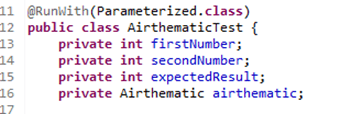Junit Continue Test From Previous Test
What is Parameterized Test in Junit?
Parameterized test is to execute the same test over and over again using different values. It helps developer to save time in executing same test which differs only in their inputs and expected results.
Using Parameterized test, one can set up a test method that retrieves data from some data source.
Consider a simple test to sum different numbers. The code may look like –

The approach above leads to lot of redundancy.
We need a simple approach and. Using parameterized test you can just add a method to input 10 data inputs and your test will run 10 times automatically.
Steps to create a Parameterized JUnit test
Following code shows an example for a parameterized test. It tests sum() method of the Arithmetic class :
Step 1) Create a class. In this example, we are going to input two numbers by using sum (int,int) method which will return the sum of given numbers

Step 2) Create a parameterized test class

Code Explanation
- Code Line 11: Annotate your test class using @runWith(Parameterized.class).
- Code Line 13: Declaring the variable 'firstNumber' as private and type as int.
- Code Line 14: Declaring the variable 'secondNumber'as private and type as int.
- Code Line 15: Declaring the variable 'expectedResult'as private and type as int.
- Code Line 16: Declaring the variable 'airthematic'as private and type as Airthematic.
@RunWith(class_name.class): @RunWith annotation is used to specify its runner class name. If we don't specify any type as a parameter, the runtime will choose BlockJunit4ClassRunner by default.
This class is responsible for tests to run with a new test instance. It is responsible for invoking JUnit lifecycle methods such as setup(associate resources) and teardown(release resources).
To parameterize you need to annotate using @RunWith and pass required .class to be tested
Step 3) Create a constructor that stores the test data. It stores 3 variables

Step 4) Create a static method that generates and returns test data.

Code Line 32,33: Creating a two-dimensional array (providing input parameters for addition). Using asList method we convert the data into a List type. Since, the return type of method input is collection.
Code Line 30: Using @Parameters annotation to create a set of input data to run our test.
The static method identified by @Parameters annotation returns a Collection where each entry in the Collection will be the input data for one iteration of the test.
Consider the elemenent
{1,2,3}
Here
firstNumber =1
secondNumber=2
expectedResult=3
Here each array element will be passed to the constructor, one at a time as the class is instantiated multiple times.
Step 5) The complete code

Code Explanation:
- Code Line 25: Using @Before annotation to setup the resources (Airthematic.class here). The @Before annotation is used here to run before each test case. It contains precondition of the test.
- Code Line 36: Using @Test annotation to create our test.
- Code Line 39: Creating an assert statement to check whether our sum is equivalent to what we expected.
Step 6) Create a test runner class to run parameterized test:

Code Explanation:
- Code Line 8: Declaring the main method of the class test which will run our JUnit test.
- Code Line 9: Executing test cases using JunitCore.runclasses, it will take the test class name as a parameter (In our example we are using Airthematic.class).
- Code Line 11: Processing the result using for loop and printing out failed result.
- Code Line 13: Printing out the successful result.
Output:
Here is the output which shows successful test with no failure trace as given below:

See the result on console,which shows addition of two numbers :-

Summary:
Parameterized test enables developer to execute the same test over and over again using different values.
Important annotations to be used during parameterization
- @RunWith
- @Parameters
Source: https://www.guru99.com/junit-parameterized-test.html
Belum ada Komentar untuk "Junit Continue Test From Previous Test"
Posting Komentar